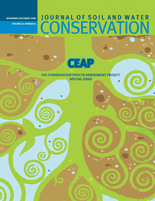|
| |
Conservation Effects Assessment Project (CEAP)
Updated 12/15/2008
The Conservation Effects Assessment Project (CEAP) began in 2003 as a multi-agency effort to quantify the
environmental
benefits
of conservation practices used by private landowners participating in selected U.S. Department of Agriculture (USDA) conservation programs.
The project consists of three components:
- National Assessment -
Providing national summary estimates of conservation practice benefits and assessing the potential for USDA conservation programs to meet the nation’s environmental and conservation goals. Cropland, wetlands,
wildlife and grazing lands will be assessed.
- Watershed Assessment Studies -
Basic research on conservation practices in selected watersheds nationwide to provide a framework for evaluating and improving performance of national assessment models.
- Bibliographies and Literature Reviews -
Current literature on conservation programs. Four literature reviews are being developed that will document what is
known and not known about the environmental benefits of conservation
practices and programs for cropland, fish and wildlife, wetlands, and
grazing lands.
...More background information about CEAP
Some documents on this page require
Acrobat Reader.
What's New

-
Overview: Enhancing conservation on agricultural landscapes: A new direction for the Conservation Effects Assessment Project,
Journal of Soil and Water Conservation, 63:6, pp. 198A-203A. November 2008 (PDF; 0.6 MB)
-
Overview: The first five years of the Conservation Effects Assessment Project,
Journal of Soil and Water Conservation, 63:6, pp. 185A-197A. November 2008 (PDF; 1.9 MB)
Watersheds: CEAP Watershed Studies are highlighted in CEAP Special Issue of the Journal of Soil and Water Conservation,
November 2008 -
Wetlands: Background summaries for the Wetlands Component Collaborative Studies, CEAP Backgrounders, November 2008
Wetlands:
CEAP Wetlands Work Plan, October 2008 (PDF; 0.5 MB) Wildlife: WRP Supports Migrating Waterfowl in Nebraska’s Rainwater Basin Region, Conservation Insight, September 2008 (PDF; 0.4 MB) Wetlands: Integrated Landscape Monitoring - Prairie Potholes Pilot: Tier II Study Plan, September 2008 (PDF; 1.2 MB) Wildlife: Effects of Agricultural Conservation Practices on Fish and Wildlife, Bibliography, August 2008
| |
|
